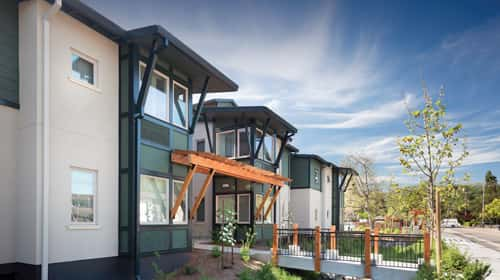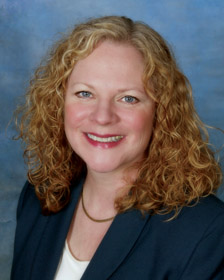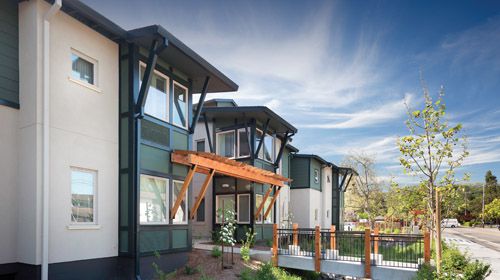
Of the 41.4 million Americans aged 65 or older, 8.7 percent are living in poverty, according to 2011 U.S. Census data. With the number of older Americans projected to climb to 92 million by 2060, communities across the country are going to be faced with housing a rising number of low-income seniors.
City and state governments are already working closely with a dedicated group of nonprofit agencies and housing developers to create and maintain low-cost, accessible housing for today’s seniors and to plan for future demand. Here’s a look inside the steps being taken locally to create homes where these seniors can be healthy, safe and connected for a lifetime.
Building communities
Since the Low income Housing Tax Credit (LIHTC) was created in 1986, the demand for low-income senior housing has increasingly been met through new construction by private developers, including nonprofit affordable housing developers, some of whom have been working in the Bay Area for decades. One such developer, Eden Housing of Hayward (www.edenhousing.org), has built or acquired more than 7,000 affordable housing units for families and seniors in 10 California counties, including Marin and Sonoma, since it was founded in 1968.
 New developments are paid for by a variety of government agencies through a complex system of housing programs and tax credits; this system was made even harder when redevelopment agencies were eliminated in California. “We work with a couple of state and federal programs, but our primary source of financing is the federal low-income housing tax credit,” says Linda Mandolini, president of Eden Housing. “States are awarded these credits on a per-capita basis and then allocate the credits for affordable housing development.”
New developments are paid for by a variety of government agencies through a complex system of housing programs and tax credits; this system was made even harder when redevelopment agencies were eliminated in California. “We work with a couple of state and federal programs, but our primary source of financing is the federal low-income housing tax credit,” says Linda Mandolini, president of Eden Housing. “States are awarded these credits on a per-capita basis and then allocate the credits for affordable housing development.”
Mandolini says communities generally approach Eden to partner on meeting a requirement for affordable housing in their cities or to evaluate potential sites. “We also do a lot of work with major home builders in the region because of low-income requirements that cities have put on them as part of larger subdivision work,” she says.
PEP Housing (www.pephousing.org), originally known as Petaluma Ecumenical Properties, is another nonprofit developer building and managing properties in Northern California. PEP was founded in 1978 by church and city leaders specifically to address the housing needs of low-income seniors. “Initially, we only worked in Petaluma, but now we’re starting to serve other cities as people have come to us asking us to bring our model to their communities,” says Mary Stompe, executive director of PEP. To date, PEP has developed more than 330 senior units in 14 locations in Sonoma and Marin counties, with 100 more units under construction.
Rents in these low-income housing developments are highly regulated and are based on the total household income. For example, in some developments, financed under certain federal Housing and Urban Development (HUD) programs, residents pay only 30 percent of their adjusted incomes, minus medical expenses, in rent. Other developments’ rents are set to levels between 30 to 50 percent of the county’s median income, no matter the resident’s actual income. All properties have maximum income levels.
The average rent for a one-bedroom apartment with Eden ranges from $500 to $900 per month. “If you’re living on a fixed income as a senior, your two biggest expenses are housing and medical bills,” explains Mandolini. “If you’re only making $14,000 to $15,000 per year, and your rent is $1,000 per month, then pretty much your whole income has to go to rent. The ability to pay just $500 per month in rent is a huge help to them.” The average Social Security income for a retired worker in 2012 was $14,760.
PEP’s waiting lists can be long, with seniors often waiting 12 to 18 months for set rate apartments and closer to two years for adjusted rate units, while Eden’s combined waiting list for their 5,000 family and senior housing units recently reached 10,000 people. Some clients wait two to three years for an apartment to open up, even longer in high-demand areas like Marin County and Silicon Valley. Mandolini recalls opening a waiting list for senior housing in Fremont last year and finding seniors lined up at 4 a.m. just to get their names on the list.
Napa Valley Community Housing
In Napa County, 16 percent of the population is currently 65 or older, slightly higher than the 12.1 percent statewide average. Many of the county’s low-income seniors have found a home through Napa Valley Community Housing (NVCH), a local nonprofit that builds, rehabilitates and manages affordable housing for families and seniors throughout the county.
Since 1990, working alone or with other organizations, NVCH has built more than 600 housing units and helped rehabilitate more than 200 others. NVCH built and manages Napa Senior Apartments in Napa, also known as “The Reserve.” Built in 2002 in partnership with USA Homes, the Reserve is a 117-unit, low-income senior development that features a community room, swimming pool and a senior resident services coordinator on staff. NVCH also helped to develop the 78-unit Jefferson Street Senior Housing in Napa, which is managed by Christian Church Home.
 Kathleen Dreessen, executive director of NVCH, says she’s seeing demand for affordable senior housing rise, in part due to the overall scarcity of affordable housing throughout the county. At the same time, government funding for affordable housing is becoming more difficult to get and there’s less of it to go around. The organization depends mainly on government grants and contributions from private sources, as well as fees collected for property management, so the loss of redevelopment funds weren’t such an issue for it. “The state and county are still very generous, but we can’t really rely on them as we did in the past,” she says.
Kathleen Dreessen, executive director of NVCH, says she’s seeing demand for affordable senior housing rise, in part due to the overall scarcity of affordable housing throughout the county. At the same time, government funding for affordable housing is becoming more difficult to get and there’s less of it to go around. The organization depends mainly on government grants and contributions from private sources, as well as fees collected for property management, so the loss of redevelopment funds weren’t such an issue for it. “The state and county are still very generous, but we can’t really rely on them as we did in the past,” she says.
With funds for new construction growing scarce, Dreessen says NVCH will most likely be turning its focus away from new construction in the next few years and toward rehabilitating properties it already owns. “There’s a little bit more money now for rehabbing properties, so that’s what a lot of builders are doing currently,” she says.
Rehabilitating existing properties
Rehabilitating existing properties looks to become an increasingly important part of the housing picture as state and federal housing funds dry up. On a larger scale, groups like NVCH are able to coordinate work on multi-unit dwellings, like the 140-unit Napa Park Homes in Napa, which they rehabbed for family and senior affordable housing in 2009. Those types of projects can be costly depending on the type of work required to bring them up to current housing standards, such as new plumbing or lead paint abatement, and whether residents need to be relocated during the work.
On a smaller scale, a nonprofit called Rebuilding Together is partnering with cities, local businesses and community volunteers to complete this work one house at a time. Rebuilding Together (originally known as Christmas in April) is a national organization with chapters around the country, including Santa Rosa, Rohnert Park-Cotati and Petaluma, that works with low-income seniors, veterans and people with disabilities to provide critical home repairs that residents are physically and financially unable to complete themselves.
Rebuilding Together Petaluma (www.rtpetaluma.org) coordinates several large volunteer days per year, like the upcoming volunteer day on October 19, and addresses urgent needs like leaks or broken water heaters throughout the year. It normally tackles about 40 homes per year, but had to cut back last year due to funding cuts, even though requests for its help have increased.
Jane Hamilton, a member of the Petaluma City Council from 1992 to 2000, is the executive director of Rebuilding Together Petaluma (RTP). [PEP’s Stompe, who also served on the Petaluma City Council from 1995 to 1998, served as RTP’s first executive director.] Hamilton says that 90 percent of RTP’s clients are seniors, with most suffering from at least one disability. They must submit thorough financial information to ensure their eligibility under HUD’s low-income guidelines.
RTP’s team of more than 500 active volunteers, which includes electricians, plumbers, carpenters and just those willing to pick up a hammer or paintbrush, tackles repairs like rotted porch railings and water-damaged bathroom floors, making the homes safer and more energy efficient. “After we’ve done a home, residents usually see their bills go down and their quality of life vastly improved,” says Hamilton. “This lets seniors stay in their homes and maintain their independence.”
RTP has had to scale back its services during the state’s budget crisis, but the HUD funds it received this year have been helping. “Right now we’re not in the crisis we were in the beginning of the year, but we expect it to be a temporary reprieve, since federal funds are predicted to start shrinking in the next two years just like the state funds did,” she predicts.
Meanwhile, support from individual donors and local businesses has made all the difference. “It’s helped us care for the most vulnerable in our society. We really rely on business sponsorships,” says Hamilton. “That’s what pulls us through.” Businesses often sponsor the cost of a project’s materials and encourage their employees to volunteer their time to the project, working alongside RTP volunteers with the necessary specialized skills.
New developments
We’re still seeing some new housing developments being built in the North Bay, but the competition for funding is fierce. In May, Eden Housing celebrated the opening of Warner Creek Senior Housing in Novato. Warner Creek’s 2.27-acre site, located on Diablo Avenue near the Margaret Todd Senior Center, had 60 units available for low-income seniors aged 62 and older who met eligibility requirements. All were leased prior to its opening, with 260 applicants vying for the 60 apartments.
Eden is currently in predevelopment on an joint senior housing development in San Rafael with Whistlestop, a Marin nonprofit that offers food, transportation and activities for seniors and people with disabilities. The development will be located in downtown San Rafael, next to the future SMART line on property already owned by Whistlestop, and will combine housing and services in one location. Mandolini says coordination among the key players should kick off in earnest in the last quarter of this year.
PEP opened Toussin Senior Apartments in Kentfield in 2011 and Acacia Senior Apartments in Santa Rosa in 2012. Its newest development, expected to open in September 2014, is the 50-unit Kellgren Senior Apartments on Wood Sorrel Drive in Petaluma. At Kellgren, PEP will be introducing its first-ever model apartment, open to residents and members of the community to come check out adaptive techniques and low-cost devices that can help make apartments safer for people as they age.
Kellgren’s units already have more than 100 people on the waiting list. PEP also anticipated starting construction on the Orange Tree Senior Apartments, in the Butte County town of Oroville, in August 2013.
Aging in place
These senior developments are providing residents with more than just an affordable place to stay. Communities are carefully designed to let residents “age in place,” helping meet their physical, emotional and practical needs throughout the rest of their lives.
Eden’s affiliate enterprise, Eden Housing Resident Services, Inc., coordinates visits from nursing students, exercise classes and flu vaccinations for Eden residents. Game days and holiday events keep neighbors engaged and decrease feelings of isolation.
PEP partners with organizations like Redwood Empire Food Bank and Petaluma Bounty to bring food into their complexes, and with local retailers to set up free monthly shops where residents can find necessities like sheets and towels. “Sometimes residents come to us with nothing more than a bag of clothing,” says Stompe. “Our resident service coordinators go above and beyond to connect them to the services they need in the community.”
Developments may feature common gathering spaces, computer rooms and community gardens. Mandolini says many cities Eden is working with are now planning their senior housing with senior centers right next door, in locations close to groceries, health centers and transit lines.
Newer buildings are also designed to be safer for elderly residents, with standard features like raised outlets, roll-in showers and side-opening ovens. “Sometimes we have three different generations of seniors living in our properties,” explains Stompe. “What a 90-year-old needs versus a 62-year-old is very different, and it’s changed the ways we look at designing and building new projects.”
All these increased services are letting seniors stay in their homes as they age, which is important with the high cost of private assisted living communities. “Unfortunately, assisted living isn’t an option if you don’t have financial resources, so it’s either independent living or convalescent care,” says Stompe. “We’re trying to keep folks in their apartments for as long as possible.”
The high cost of aging
It’s easy to just blame one factor, like the recent recession, for the number of local seniors who have to worry about keeping a roof over their heads, but the reality is more complex. What we’re seeing in the growing demand for affordable senior housing is often a combination of slow-moving erosion and a landslide.
The traditional safety nets for low-income seniors have been steadily disappearing, including the prospect of pensions and benefits to carry workers through retirement. Families are increasingly dispersed and sometimes unwilling to take on the expensive and possibly decades-long job of caring for an aging relative.
Of course, the recession hit those who don’t have time to build up their nest eggs again the hardest, and seniors looking for part-time work to supplement their incomes have had a difficult time in the recent job market. The mortgage crisis meant even some seniors who had lived in their homes for decades but had refinanced found themselves underwater and unable to keep up.
“At Warner Creek, we were surprised by the number of folks coming to us because they’d lost their homes to foreclosure,” says Mandolini. She says most of those people had lived in Marin County for many years and were now barely getting by in other apartments.
“What I’ve seen more recently is that the number of homeless seniors has increased significantly in the last year or so,” says Stompe. “They’re showing up at our doorstep saying they need a place to stay in two hours or tomorrow.” Many of those arriving at a PEP facility, homeless or not, have lost a spouse or have had major medical expenses for themselves, their spouse or their child in the last few years, and their retirement savings has just run out.
“Something big has happened in their lives that’s caused them to need rents that are more affordable,” she says. “They thought they’d planned for these years, but their lives and financial needs have exceeded their savings and, all of the sudden, they don’t have anything.”
The coming wave
Even if the economic situation improves, some of these symptoms won’t be going away any time soon. The wave of baby boomers coming into retirement age (what some are calling a “silver tsunami”) continues to grow and life expectancies remain high. That will mean looking at our senior housing supply–and the associated public services—in a whole new way.
“There’s a growing demand for this type of housing as baby boomers are getting older, and we’re really going to have to look hard at that as a community,” says Dreessen. “In a few years, there are going to be even more seniors coming on the scene, and it’s short-sighted not to realize that and provide for it now.”




